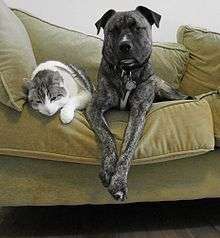Pet
A pet or companion animal is an animal kept primarily for a person's company or protection, as opposed to working animals, sport animals, livestock, and laboratory animals, which are kept primarily for performance, agricultural value, or research. The most popular pets are noted for their attractive appearances and their loyal or playful personalities.
Pets provide their owners (or guardians[1]) physical and emotional benefits. Walking a dog can supply both the human and pet with exercise, fresh air, and social interaction. Pets can give companionship to elderly adults who do not have adequate social interaction with other people, as well as other people that are living alone. There is a medically approved class of therapy animals, mostly dogs or cats, that are brought to visit confined humans. Pet therapy utilizes trained animals and handlers to achieve specific physical, social, cognitive, and emotional goals with patients.
The most popular pets are likely dogs and cats, but people also keep house rabbits, ferrets; rodents such as gerbils, hamsters, chinchillas, fancy rats, and guinea pigs; avian pets, such as canaries, parakeets, corvids and parrots; reptile pets, such as turtles, lizards and snakes; aquatic pets, such as goldfish, tropical fish and frogs; and arthropod pets, such as tarantulas and hermit crabs.
Some scholars and animal rights organizations have raised concern over pet-keeping with regards to the autonomy and objectification of nonhuman animals.
Legalities
States, cities, and towns in Western nations commonly enact local ordinances to limit the number or kind of pets a person may keep personally or for business purposes. Prohibited pets may be specific to certain breeds (such as pit bulls or Rottweilers), they may apply to general categories of animals (such as livestock, exotic animals, wild animals, and canid or felid hybrids), or they may simply be based on the animal's size. Additional or different maintenance rules and regulations may also apply. Condominium associations and owners of rental properties also commonly limit or forbid tenants' keeping of pets.
The keeping of animals as pets can cause concerns with regard to animal rights and welfare.[2][3][4] Pets have commonly been considered private property, owned by individual persons. However, many legal protections have existed (historically and today) with the intention of safeguarding pets' (and other animals') well-being.[5][6][7][8] Since the year 2000, a small but increasing number of jurisdictions in North America have enacted laws redefining pet's owners as guardians. Intentions have been characterized as simply changing attitudes and perceptions (but not legal consequences) to working toward legal personhood for pets themselves. Some veterinarians and breeders have opposed these moves. The question of pets' legal status can arise with concern to purchase or adoption, custody, divorce, estate and inheritance, injury, damage, and veterinary malpractice.[9][10][11][12]
Pet popularity
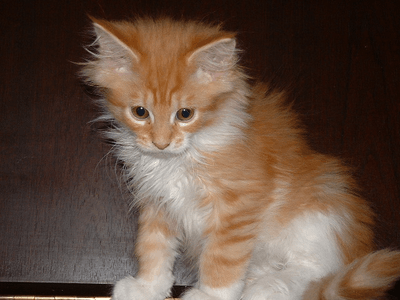
There are approximately 86.4 million pet cats in the United States, approximately 78.2 million pet dogs in the United States,[13][14] and 5.3 million house rabbits.[15] The two most popular pets in most Western countries have been cats and dogs. In the United States, a 2007–2008 survey showed that dog-owning households outnumbered those owning cats, but that the total number of pet cats was higher than that of dogs. The same was true for 2011.[16] In 2013, pets outnumbered children four to one in the United States.[17]

Most popular pets in the U.S (millions)[18][19] Pet Global population U.S. population U.S. inhabited households U.S. average per inhabited household Cat 202 93.6 38.2 2.45 Dog 171 77.5 45.6 1.70 Fish N/A 171.7 13.3 12.86 Small mammals N/A 15.9 5.3 3.00 Birds N/A 15.0 6.0 2.50 Reptiles & amphibians N/A 13.6 4.7 2.89 Equine N/A 13.3 3.9 3.41

Choice of a pet
For a small to medium-size dog, the total cost over a dog's lifetime is about $7,240 to $12,700.[20] For an indoor cat, the total cost over a cat's lifetime is about $8,620 to $11,275.[21] People most commonly get pets for companionship, to protect a home or property, or because of the beauty or attractiveness of the animals.[22] The most common reasons for not owning a pet are lack of time, lack of suitable housing, and lack of ability to care for the pet when traveling.[22][23]
United States
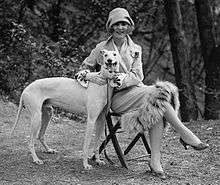
According to the 2007-2008 Pet Owners survey:[24]
| Animal | Number of U.S. households that own this kind of pet (millions) |
Total number of this kind of pet owned in the U.S. (millions) |
|---|---|---|
| Bird | 6.0 | 15.0 |
| Cat | 38.2 | 93.6 |
| Dog | 45.6 | 79.5 |
| Equine | 4.0 | 13.3 |
| Freshwater fish | 13.3 | 171.7 |
| Saltwater fish | 0.7 | 11.2 |
| Reptile | 4.7 | 13.6 |
| Small pets | 5.3 | 15.9 |
Canada
The latest survey done by Colin Siren of Ipsos Reid estimates that there are 7.9 million cats and 5.9 million dogs in Canada. The survey also shows that 35% of Canadian households have a dog, while 38% have a cat, which is consistent with other surveys conducted around the world.[25]
United Kingdom
A 2007 survey by the University of Bristol found that 26% of UK households owned cats and 31% owned dogs, estimating total domestic populations of approximately 10.3 million cats and 10.5 million dogs in 2006.[26] The survey also found that 47.2% of households with a cat had at least one person educated to degree level, compared with 38.4% of homes with dogs.[27]
Italy
Household animals in Italy are about 45 million in number, according to a survey promoted by Italian family associations in 2009: 7 million dogs, 7.5 million cats, 16 million fishes, 12 million birds, 10 million snakes plus 3,000 wild animals held as "pets", mainly lions, panthers and cheetahs.[28]
Effects on pets' health
Keeping animals as pets may be detrimental to their health if certain requirements are not met. An important issue is inappropriate feeding, which may produce clinical effects. The consumption of chocolate or grapes by dogs, for example, may prove fatal.[29]
Certain species of houseplants can also prove toxic if consumed by pets. Examples include philodendrons and Easter lilies (which can cause severe kidney damage to cats)[30][31] and poinsettias, begonia, and aloe vera (which can sicken or, in extreme cases, kill dogs).[32]
Housepets, particularly dogs and cats in industrialized societies, are also highly susceptible to obesity. Overweight pets have been shown to be at a higher risk of developing diabetes, liver problems, joint pain, kidney failure, and cancer. Lack of exercise and high-caloric diets are considered to be the primary contributors to pet obesity.[33][34][35]
Effects of pets on their caregiver's health
Health benefits
Pets might have the ability to stimulate their caregivers, in particular the elderly, giving people someone to take care of, someone to exercise with, and someone to help them heal from a physically or psychologically troubled past.[36][37][38] Animal company can also help people to preserve acceptable levels of happiness despite the presence of mood symptoms like anxiety or depression.[39] Having a pet may also help people achieve health goals, such as lowered blood pressure, or mental goals, such as decreased stress.[40][41][42][43][44][45] There is evidence that having a pet can help a person lead a longer, healthier life. In a 1986 study of 92 people hospitalized for coronary ailments, within a year 11 of the 29 patients without pets had died, compared to only 3 of the 52 patients who had pets.[38] Having pet(s) was shown to significantly reduce triglycerides, and thus heart disease risk, in the elderly.[46] A study by the National Institute of Health found that people who owned dogs were less likely to die as a result of a heart attack than those who didn’t own one.[47] There is some evidence that pets may have a therapeutic effect in dementia cases.[48] Other studies have shown that for the elderly, good health may be a requirement for having a pet, and not a result.[49] Dogs trained to be guide dogs can help people with vision impairment. Dogs trained in the field of Animal-Assisted Therapy (AAT) can also benefit people with other disabilities.[36][50]
Pets in long-term care institutions
People residing in a long-term care facility, such as a hospice or nursing home, experience health benefits from pets. Pets help them to cope with the emotional issues related to their illness. They also offer physical contact with another living creature, something that is often missing in an elder's life.[13][51] Pets for nursing homes are chosen based on the size of the pet, the amount of care that the breed needs, and the population and size of the care institution.[38] Appropriate pets go through a screening process and, if it is a dog, additional training programs to become a therapy dog.[52] There are three types of therapy dogs: facility therapy dogs, animal-assisted therapy dogs, and therapeutic visitation dogs. The most common therapy dogs are therapeutic visitation dogs. These dogs are household pets whose handlers take time to visit hospitals, nursing homes, detention facilities, and rehabilitation facilities.[37] Different pets require varying amounts of attention and care; for example, cats may have lower maintenance requirements than dogs.[53]
Connection with community
In addition to providing health benefits for their owners, pets also impact the social lives of their owners and their connection to their community. There is some evidence that pets can facilitate social interaction.[54] Assistant Professor of Sociology at the University of Colorado at Boulder, Leslie Irvine has focused her attention on pets of the homeless population. Her studies of pet ownership among the homeless found that many modify their life activities for fear of losing their pets. Pet ownership prompts them to be and act responsibly, with many making a deliberate choice not to drink or use drugs, and to avoid contact with substance abusers or those involved in any criminal activity for fear of being separated from their pet. Additionally, many refuse housing in shelters if their pet is not allowed to stay with them.[55]
Health risks
Health risks that are associated with pets include:
- Aggravation of allergies and asthma caused by dander and fur or feathers
- Falling injuries. Tripping over pets, especially dogs, causes more than 86,000 falls serious enough to prompt a trip to the emergency room each year in the United States.[56] Among elderly and disabled people, these falls have resulted in life-threatening injuries and broken bones.
- Injury, mauling, and sometimes death caused by pet bites and attacks
- Disease and/or parasites due to animal hygiene problems, lack of appropriate treatment, and undisciplined behavior (faeces and urine)
- Stress caused by behaviour of animals
Types
While many people have kept many different species of animals in captivity over the course of human history, only a relative few have been kept long enough to be considered domesticated. Other types of animals, notably monkeys, have never been domesticated but are still commonly sold and kept as pets. There are also inanimate objects that have been kept as "pets", either as a form of game, or humorously (e.g. the Pet Rock or Chia Pet).
Domesticated
Domesticated pets are the most common types of pet. A domesticated animal is any animal that has been tamed and made fit for a human environment.[57] They have consistently been kept in captivity over a long enough period of time that they exhibit marked differences in behavior and appearance from their wild relatives.
Mammals

- Alpacas
- Cows
- Donkeys
- Dogs
- Cats
- Domesticated silver foxes
- Sheep
- Horses
- Goats
- Elephants
- Rodents including fancy rats, fancy mice, hamsters, guinea pigs, gerbils, and chinchillas
- Ferrets
- Llamas
- Pigs
- Domestic rabbits
Birds
- Companion parrot
- Domestic canary
- Chickens
- Domestic turkeys
- Domestic ducks and geese
- Domestic pigeons and doves
- Finches
Fish
Wild animals

Wild animals are often kept as pets. The term wild in this context specifically applies to any species of animal which has not undergone a fundamental change in behavior to facilitate a close co-existence with humans. Some species listed here may have been bred in captivity for a considerable length of time, but are still not recognized as domesticated.
Exotic mammals
- Anteaters like southern tamanduas
- Canidae like Arctic foxes, coydogs, dingos, fennec foxes, gray foxes, and wolfdogs
- Civets like binturongs and genets
- Deer like leaf muntjacs
- Duikers
- Felidae like bobcats, ocelots, margays, and servals
- Marsupials like opossums, gliding possums, koalas, short-tailed opossums, wallabys, and wombats
- Mongoose
- Mustelids like badgers, minks, skunks, and otters
- Primates like capuchin monkeys, chimpanzees, guenons, lemurs, macaques, marmosets, slow lorises, spider monkeys, squirrel monkeys, sykes' monkeys, tamarins, and vervet monkeys
- Procyonidae like cacomistles, coatimundi, kinkajous, raccoons, and ringtail cats
- Rodents like chipmunks, degus, dormouse, flying squirrels, groundhogs, patagonian cavys, pouched rats, and prairie dogs.
- Sloths such as two-toed sloths and pale-throated three-toed sloths
- Monotremes such as platypus and echidnas
Birds
- Crows, ravens, and magpies
- Parakeets, parrots, and other talking birds
- Toucans
- Peafowl
- Birds of prey
- Aquatic birds
- Types of Old World Quail and New World Quail
Reptiles
- Iguanas
- Lizards, including bearded dragons, leopard geckos, green anoles, blue tongue skinks, monitor lizards, and green iguanas
- Snakes, including corns, kings, milks, and ball pythons
- Tortoises
- Turtles
Amphibians
Fish
- Angelfish
- Barb
- Cichlid
- Corydoras
- Danio
- Discus
- Gourami
- Live-bearer
- Loach
- Mbuna
- Rainbowfish
- Rasbora
- Tetra
- Blenny
- Boxfish
- Butterflyfish
- Chromis
- Clownfish
- Damsel
- Goby
- Tang
- Triggerfish
- Wrasse
Arthropods
- Ants
- Caterpillars
- Centipedes
- Crabs and hermit crabs
- Millipedes
- Praying mantises
- Stick insects
- Sea-Monkeys
- Triops
- Tarantulas and other spiders
History
Archaeology suggests that dogs as pets may date back to at least 12,000 years ago.[58]
Victorian Era: The Rise of Pet Keeping
Animals were typically used for ‘utility’ and practical purposes. The church deemed affection for animals as immoral and against natural order. Divine justification implied that the purpose for animals was to sustain humanity.[59] However, throughout the seventeenth and eighteenth century pet keeping gradually became accepted throughout Britain. Initially, aristocrats kept dogs for both companionship and hunting. Thus, pet keeping was a sign of elitism within society. By the nineteenth century, the rise of the middle class stimulated the development of pet keeping and it became inscribed within the bourgeois culture.[60]
Economy
As the popularity of pet keeping rose during the Victorian Era, animals became a fixture within urban culture as commodities and decorative objects.[61] Pet keeping generated a commercial opportunity for entrepreneurs. By the mid-nineteenth century, nearly twenty thousand street vendors in London dealt with live animals.[62] Also, the popularity of animals developed a demand for animal goods such as accessories and guides for pet keeping. Pet care developed into a big business by the end of the nineteenth century.[63]
Profiteers also sought out pet stealing as a means for economic gain. Utilizing the affection owner’s had for their pets, professional dog stealers would capture animals and hold them for ransom.[64] The development of dog stealing reflects the increased value of pets. Pets gradually became defined as property of their owners. Laws were created that punished offenders for their burglary.[65]
Social
Pets and animals also had social and cultural implications throughout the nineteenth century. The categorization of dogs by their breeds reflected the hierarchical, social order of the Victorian Era. The pedigree of a dog represented the high status and lineage of their owners and reinforced social stratification.[66] Middle-class owners, however, valued the ability to associate with the upper-class through ownership of their pets. The ability to care for a pet signified respectability and the capability to be self-sufficient.[67] According to Harriet Ritvo, the identification of “elite animal and elite owner was not a confirmation of the owner’s status but a way of redefining it.”[68]
Entertainment
The popularity of dog and pet keeping generated animal fancy. Dog fanciers showed enthusiasm for owning pets, breeding dogs, and showing dogs in various shows. The first dog show took place on 28 June 1859 in Newcastle and focused mostly on sporting and hunting dogs.[69] However, pet owners produced an eagerness to demonstrate their pets as well as have an outlet to compete.[70] Thus, pet animals gradually were included within dog shows. The first large show, which would host one thousand entries, took place in Chelsea in 1863.[71] The Kennel Club was created in 1873 to ensure fairness and organization within dog shows. The development of the Stud Book by the Kennel Club defined policies, presented a national registry system of purebred dogs, and essentially institutionalized dog shows.[72]
Pets in art
 Katharine of Aragon with a monkey
Katharine of Aragon with a monkey The Girl with the Marmot by Jean-Honoré Fragonard
The Girl with the Marmot by Jean-Honoré Fragonard
 - Young Lady with parrot by Édouard Manet 1866
- Young Lady with parrot by Édouard Manet 1866._Oudste_zuster_van_Louis_Metayer_Rijksmuseum_SK-A-2140.jpeg) Antoinette Metayer (1732–88) and her pet dog
Antoinette Metayer (1732–88) and her pet dog The Lady with an Ermine
The Lady with an Ermine Sir Henry Raeburn - Boy and Rabbit
Sir Henry Raeburn - Boy and Rabbit Eos, A Favorite Greyhound of Prince Albert
Eos, A Favorite Greyhound of Prince Albert Signal, a Grey Arab, with a Groom in the Desert
Signal, a Grey Arab, with a Groom in the Desert Eduardo Leon Garrido. An Elegant Lady with her Dog
Eduardo Leon Garrido. An Elegant Lady with her Dog The Fireplace depicting a Pug, James Tissot
The Fireplace depicting a Pug, James Tissot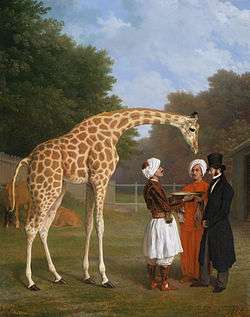
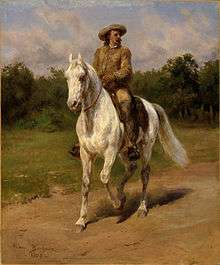 Rosa Bonheur - Portrait of William F. Cody
Rosa Bonheur - Portrait of William F. Cody

- Hunt
See also
|
References
- ↑ "Guardianship Movement". Pet Planet Health. Retrieved 10 February 2015.
- ↑ "About Us". NhRP Website. Nonhuman Rights Project. Retrieved 29 August 2013.
- ↑ "About IDA". IDA Website. In Defense of Animals. Retrieved 29 August 2013.
- ↑ "Animal Rights Uncompromised: 'Pets'". PETA Website. People for the Ethical Treatment of Animals. Retrieved 21 September 2012.
- ↑ Garner, Robert. "A Defense of a Broad Animal Protectionism," in Francione and Garner 2010, pp. 120–121.
- ↑ Francione, Gary Lawrence (1996). Rain without thunder: the ideology of the animal rights movement. ISBN 978-1-56639-461-1.
- ↑ Francione, Gary. Animals, Property, and the Law. Temple University Press, 1995.
- ↑ Garner 2005, p. 15; also see Singer, Peter. Animal Liberation, Random House, 1975; Regan, Tom. The Case for Animal Rights, University of California Press, 1983; Francione, Gary. Animals, Property, and the Law. Temple University Press, 1995; this paperback edition 2007.
- ↑ "Do You Live in a Guardian Community?". The Guardian Campaign. Retrieved 1 September 2013.
- ↑ Nolen, R. Scott (1 March 2005). "Now, it's the lawyers' turn.". Journal of the American Veterinary Medical Association. Retrieved 29 August 2013.
- ↑ Chapman, Tamara (March–April 2005). "Owner or Guardian?" (PDF). Trends Magazine. Retrieved 29 August 2013.
- ↑ Katz, Jon (5 March 2004). "Guarding the Guard Dogs?". Home / Heavy Petting: Pets & People. Slate. Retrieved 29 August 2013.
- 1 2 http://www.shea-online.org/Portals/0/PDFs/Animals%20in%20Healthcare%20Facilities.pdf
- ↑ The Humane Society of the United States. "U.S. Pet Ownership Statistics". Retrieved 27 April 2012.
- ↑ USDA. "U.S. Rabbit Industry profile" (PDF). Retrieved 10 July 2013.
- ↑ U.S. Pet Ownership & Demographics Sourcebook (2012)
- ↑ Daniel Halper (1 February 2013). "Animal Planet: Pets Outnumber Children 4 to 1 in America". The Weekly Standard. Retrieved 9 February 2013.
- ↑ Susan Hayes. "What are the most popular pets around the world?". PetQuestions.com. Retrieved 4 March 2011.
- ↑ "Industry Statistics & Trends". American Pet Product Association. Retrieved 4 March 2011.
- ↑ Lieber, Alex. "Lifetime Costs of Dog Ownership". Retrieved 27 April 2012.
- ↑ Lieber, Alex. "Lifetime Costs of Cat Ownership". Retrieved 27 April 2012.
- 1 2 Leslie, Be; Meek, Ah; Kawash, Gf; Mckeown, Db (April 1994). "An epidemiological investigation of pet ownership in Ontario" (Free full text). The Canadian veterinary journal. La revue veterinaire canadienne. 35 (4): 218–22. ISSN 0008-5286. PMC 1686751
 . PMID 8076276.
. PMID 8076276. - ↑ http://www.nyshipping.com/pet-relocation
- ↑ "Industry Statistics & Trends". American Pet Products Manufacturers Association, Inc. Retrieved 14 December 2009.
- ↑ "Latest Pet Population Figures Released" (PDF). Canadian Animal Health Institute. Retrieved 26 July 2008.
- ↑ "UK domestic cat and dog population larger than thought". University of Bristol. 6 February 2010.
- ↑ "More cat owners 'have degrees' than dog-lovers". BBC News Online. 6 February 2010.
- ↑ "45 milioni gli animali domestici in Italia: 150.000 ogni anno vengono abbandonati". Il Messaggero. 22 September 2009.
- ↑ Mason Woods, Elizabeth. "Toxic and Dangerous Foods for Pets". Retrieved 13 December 2014.
- ↑ "Plants and Your Cat". Cat Fanciers' Association. Archived from the original on 17 January 2010. Retrieved 15 May 2007.
- ↑ Langston, Cathy E. (1 January 2002). "Acute Renal Failure Caused by Lily Ingestion in Six Cats". Journal of the American Veterinary Medical Association. 220 (1): 49–52, 36. doi:10.2460/javma.2002.220.49. PMID 12680447.
- ↑ "These plants can be poisonous to dogs". Sunset Magazine. Retrieved 17 October 2013.
- ↑ "Overweight Dogs". Pet Care. The American Society for the Prevention of Cruelty to Animals (ASPCA). Retrieved 17 October 2013.
- ↑ "Overweight Cats". Pet Care. The American Society for the Prevention of Cruelty to Animals (ASPCA). Retrieved 17 October 2013.
- ↑ Zelman, Joanna (23 February 2011). "Pet Obesity: Over Half Of U.S. Dogs And Cats Are Overweight, Study Says". Huffington Post. Retrieved 17 October 2013.
- 1 2 "The Health Benefits of Pets". US Government National Institute of Health. Retrieved 25 December 2006.
- 1 2 Reiman, Steve. "Therapy Dogs in the Long-Term Health Care Environment" (PDF). Retrieved 27 April 2012.
- 1 2 3 Whiteley, Ellen H. (1986). "The Healing Power of Pets". 258 (7). Saturday Evening Post. pp. 2–102. Retrieved 5 November 2006. Academic Search Elite. EBSCOhost. Polk Library, UW Oshkosh
- ↑ Bos, E.H.; Snippe, E.; de Jonge, P.; Jeronimus, B.F. (2016). "Preserving Subjective Wellbeing in the Face of Psychopathology: Buffering Effects of Personal Strengths and Resources". PLOS ONE. 11: e0150867. doi:10.1371/journal.pone.0150867.
- ↑ Asp, Karen (2005). "Volunteer Pets". Prevention. 57 (4): 176–78. Retrieved 5 November 2006. Academic Search Elite. EBSCOhost. Polk Library, UW Oshkosh
- ↑ Allen, K; Shykoff, Be; Izzo, Jl, Jr (1 October 2001). "Pet ownership, but not ace inhibitor therapy, blunts home blood pressure responses to mental stress" (Free full text). Hypertension. 38 (4): 815–20. ISSN 0194-911X. PMID 11641292.
- ↑ Kingwell, Ba; Lomdahl, A; Anderson, Wp (October 2001). "Presence of a pet dog and human cardiovascular responses to mild mental stress". Clinical Autonomic Research. 11 (5): 313–7. doi:10.1007/BF02332977. ISSN 0959-9851. PMID 11758798.
- ↑ Wilson, Cc (October 1987). "Physiological responses of college students to a pet". The Journal of Nervous and Mental Disease. 175 (10): 606–12. doi:10.1097/00005053-198710000-00005. ISSN 0022-3018. PMID 3655768.
- ↑ Koivusilta, Leena K.; Ojanlatva, A; Baune, Bernhard (2006). Baune, Bernhard, ed. "To Have or Not To Have a Pet for Better Health?". PLoS ONE. 1 (1): e109. doi:10.1371/journal.pone.0000109. PMC 1762431
 . PMID 17205113.
. PMID 17205113. - ↑ Vormbrock, Jk; Grossberg, Jm (October 1988). "Cardiovascular effects of human–pet dog interactions". Journal of behavioral medicine. 11 (5): 509–17. doi:10.1007/BF00844843. ISSN 0160-7715. PMID 3236382.
- ↑ Dembicki, D and Anderson, J. 1996. Journal of Nutrition in Gerontology and Geriatrics. Volume 15 Issue 3, pages 15-31.
- ↑ Jodee. "Want to Reduce Risk of Heart Disease? Get a Pet". Retrieved 27 April 2012.
- ↑ Friedmann E, Galik E, Thomas SA, Hall PS, Chung SY, McCune S. Evaluation of a Pet-Assisted Living Intervention for improving functional status in assisted living residents with mild to moderate cognitive impairment. American Journal of Alzheimer's Disease and Other Dementias.2015:30(3):276-289
- ↑ Parslow, Ruth; Jorm, Anthony; Christensen, Helen; Rodgers, Bryan; Jacomb, Patricia (Jan–Feb 2005). "Pet Ownership and Health in Older Adults". Gerontology. 40. www.karger.com/ger: Karger. 51 (1): 40–47. doi:10.1159/00081433.
- ↑ Farlex. "The Free Dictionary By Farlex". Retrieved 27 April 2012.
- ↑ Reinman, Steve. "Therapy Dogs in the Long-Term Health Care Environment" (PDF). Retrieved 27 April 2012.
- ↑ Huculak, Chad (4 October 2006). "Super Furry Animals". Edmonton: W7.. LexisNexis. Polk Library, UW Oshkosh. 5 November 2006.
- ↑ Bruck, Laura (1996). "Today's Ancillaries, Part 2: Art, music and pet therapy". Nursing Homes: Long Term Care Management. 45 (7): 36. Retrieved 5 November 2006. Academic Search Elite. EBSCOhost. Polk Library, UW Oshkosh.
- ↑ Wood L, Martin K, Christian H, Nathan A, Lauritsen C, Houghton S, Kawachi I, McCune S. The pet factor - Companion animals as a conduit for getting to know people, friendship formation and social support. PLoS One. 2015:10(4):e0122085
- ↑ Irvine, Leslie (2013). My Dog Always Eats First: Homeless People and Their Animals. Boulder, CO: Lynne Rienner Publishers, Inc.
- ↑ "In the Home, a Four-Legged Tripwire". The New York Times. 27 March 2009.
- ↑ Farlex. "The Free Dictionary by Farlex". Retrieved 27 April 2012.
- ↑ Clutton-Brock, Juliet (1995). "Origins of the dog: domestication and early history". In Serpell, James. The domestic dog: its evolution, behaviour and interactions with people. Cambridge: Cambridge University Press. pp. 10–11. ISBN 9780521425377.
- ↑ Ritvo, Harriet (1987). The Animal Estate: The English and Other Creatures in the Victorian Age. Cambridge: Harvard University Press. p. 17.
- ↑ Amato, Sarah (2015). Beastly Possession: Animals in the Victorian Consumer Culture. Toronto: University of Toronto Press. p. 25.
- ↑ Amato, Sarah (2015). Beastly Possessions: Animals in Victorian Consumer Culture. University of Toronto Press. p. 6.
- ↑ Ritvo, Harriet (1987). The Animal Estate: The English and Other Creatures in the Victorian Age. Cambridge: Harvard University Press. p. 86.
- ↑ Amato, Sarah (2015). Beastly Possession: Animals in Victorian Consumer Culture. Toronto: University of Toronto Press. p. 48.
- ↑ Philo, Chris (1989). Animal Space, Beastly Places: New Geographies of Human-Animal Relations. Routledge. pp. 38–389.
- ↑ Philo, Chris (1989). Animal Space, Beastly Places: New Geographies of Human-Animal Relations. Routledge. p. 41.
- ↑ Amato, Sarah (2015). Beastly Possession: Animals in Victorian Consumer Culture. Toronto: University of Toronto Press. p. 55.
- ↑ Amato, Sarah (2015). Beastly Possession: Animals in Victorian Consumer Culture. Toronto: University of Toronto Press. p. 10.
- ↑ Ritvo, Harriet (1987). The Animal Estate: The English and Other Creatures in the Victorian Era. Cambridge: Harvard University Press. p. 104.
- ↑ Ritvo, Harriet (1987). The Animal Estate: The English and Other Creatures in Victorian Age. Cambridge: Harvard University Press. pp. 7–8.
- ↑ Ritvo, Harriet (1987). The Animal Estate: The English and Other Creatures in the Victorian Age. Cambridge: Harvard University Press. p. 98.
- ↑ Ritvo, Harriet (1987). The Animal Estate: The English and Other Creatures in the Victorian Age. Cambridge: Harvard University Press. p. 66.
- ↑ Ritvo, Harriet (1987). The Animal Estate: The English and Other Creatures in the Victorian Age. Cambridge: Harvard University Press. p. 104.
External links
- Companion Animal Demographics in the United States: A Historical Perspective from The State of the Animals II: 2003
| Wikibooks has a book on the topic of: How to choose your pet and take care of it |
| Wikimedia Commons has media related to Pets. |
| Look up pet in Wiktionary, the free dictionary. |
